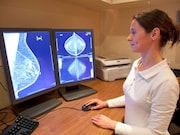Method combines radiomics with three-compartment breast image analysis of dual-energy mammography
THURSDAY, Dec. 13, 2018 (HealthDay News) — A novel technique, quantitative three-compartment breast (3CB) image analysis of dual-energy mammography combined with mammography radiomics, could reduce unnecessary breast biopsies, according to a study published online Dec. 11 in Radiology.
Karen Drukker, Ph.D., from the University of Chicago, and colleagues examined the combination of mammography radiomics and quantitative 3CB image analysis of dual-energy mammography in a prospective study. Dual-energy craniocaudal and mediolateral oblique mammograms were obtained before biopsy in 109 women with Breast Imaging Reporting and Data System category 4 or 5 breast masses (35 invasive cancers and 74 benign). The three quantitative compartments of water, lipid, and protein thickness were calculated at each pixel. A linear discriminant classifier with predefined feature signatures was used to differentiate between water-lipid-protein composition images alone, mammography radiomics alone, and a combined image analysis. The primary performance metric was positive predictive value of biopsy (PPV3) at maximum sensitivity.
The researchers found a PPV3 for conventional diagnostic digital mammography of 32.1 percent, with 100 percent sensitivity. For combined mammography radiomics plus quantitative 3CB image analysis, the PPV3 was 49 percent, with 97 percent sensitivity and 35.8 percent fewer biopsies.
“Our study showed that more investigation into the application of 3CB imaging is warranted, and we have initiated a research study incorporating 3CB imaging into breast tomosynthesis,” the authors write.
Two authors disclosed financial ties to the medical device and medical technology industries.
Copyright © 2018 HealthDay. All rights reserved.








